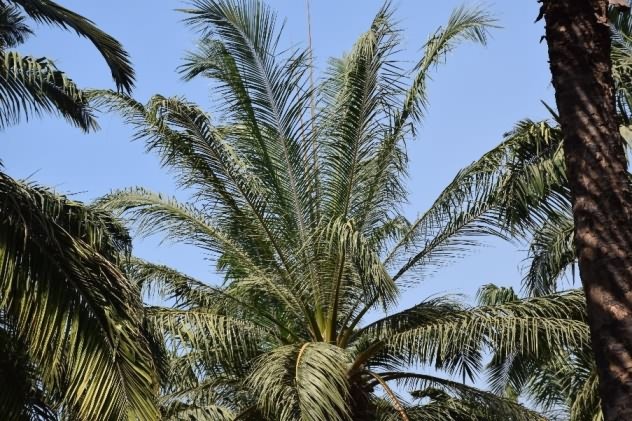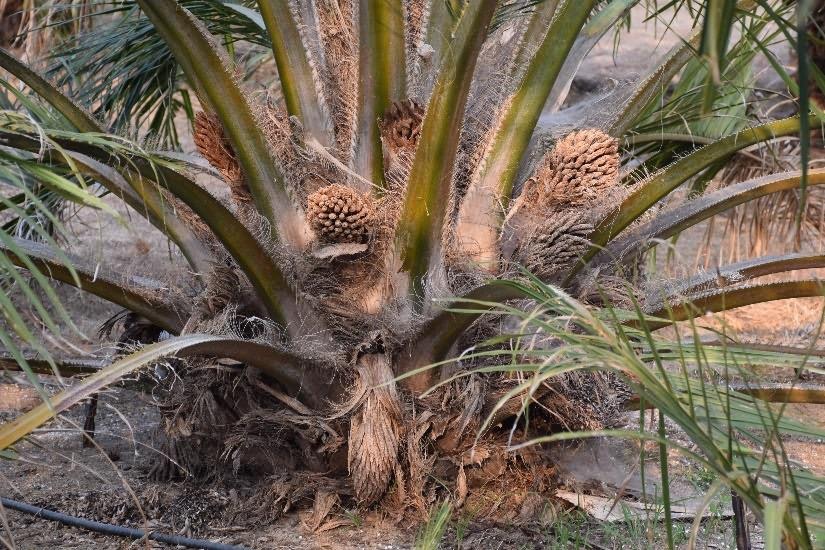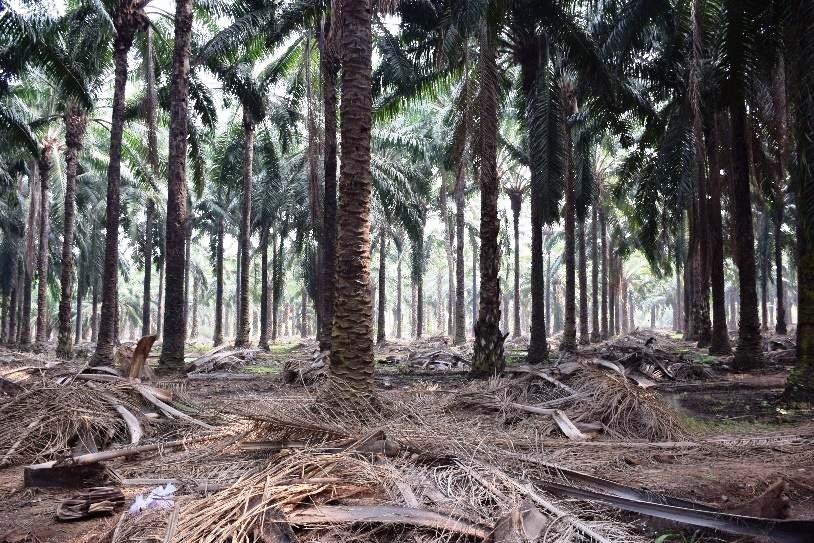गर्म मौसम की स्थिति के दौरान तेल ताड का प्रबंधन कैसे करें?
Oil palm is a humid tropical crop which requires a very high annual rainfall of more than 2000 mm well distributed @150 mm per month. In India, very few locations receive rainfall throughout the year and it is not sure that the amount will exceed 150 mm per month or not.
That is why oil palm is grown and promoted as irrigated crop in India except in few pockets of high rainfall areas. This crop requires around 150 to 200 litres of water per day per palm during juvenile phase and around 200 to 250 litres per day per palm for adult plantations.
What happens if water requirement is not met?
If the palm does not get enough water, the number of spear leaves increases as it hinders the opening of spear leaves and finally leaf production gets affected. Further continuance of drought conditions results in necrosis of older leaves, young leaves and ultimately roots.
In juvenile palms, photosynthetic activity gets affected, leaves become yellow and leaf tips bronze coloured. In some cases, rolling of lower leaflets also can be seen. In matured palms, rolling of leaflets of mature leaves, reduction in photosynthesis and finally wilting and drying of leaves.
These symptoms finally end up with the production of more male flowers thereby reduction in FFB yield and also reduced oil content.
Irrigating oil palm at optimal levels
Plant requires water to meet its evapotranspirational demand and in a very small extent towards its metabolic purposes. Water needs to be provided to meet these demands and so it differs from day to day because of the prevailing weather conditions.
Further, the age of the crop and soil type also decides the water required per palm. There are different methods of irrigation viz., flood, microjet and drip irrigation followed in oil palm under Indian conditions.
Usually it is observed that the yields are satisfactory under flood irrigation in comparison with other micro irrigation methods. However, the yield reduction due to controlled application of irrigation water is insignificant in comparison with the benefits of economized water use.
Irrigation management of oil palm under dry weather conditions
Water requirement depends upon the potential evapotranspiration and crop factor. Under the conditions of West Godavari, it is estimated that oil palm requires 215 to 265 litres in summer, 100 to 150 litres in rainy season and 160 to 170 litres during winter.
Hot weather conditions prevail during March to June in most parts of the country and oil palm requires more water during this time only. The underground water level also goes down during this season. Under such conditions oil palm needs to be given a special care to overcome these adverse conditions.
- Research results indicate that growing of nursery during rainy season is more appropriate rather than any other season. Though enough water is provided for irrigating nursery plants, the prevailing conditions during rainy season, favour better growth and health of nursery plants. So, it is better to avoid planting nursery during summer season.
- During transplanting in main field, nursery plants face a sort of shock immediately after planting. This effect can be more seen during summer (March to June) planting as it causes more mortality in the main field. Therefore, it is suggested to go for transplanting during rainy season (July to December) as it will provide more favourable conditions for better establishment of the crop and thereby better crop stand.
- Growing of green manure crops like daincha in the basins of young palms (1-3 years) improves the water retention by reducing evaporational loss. This also helps to protect the young palms from hot waves, to control weeds and create better micro environment. These crops can be grown in the basin leaving 1 m space from the trunk and they need to be incorporated at flowering stage to act as a mulch and also add organic matter to the soil.
- Generally, a plant diverts more water and nutrition towards reproductive parts rather than vegetative parts, if a choice is to be made. Ablation is recommended to avoid this diversion. Removal of male and female inflorescences during juvenile phase (1-3 years) is called Ablation in oil palm. Ablation helps in making more water and nutrients available for growth function and thereby to have more healthy plants.
- During first three years, each oil palm requires around 100-150 litres of water per day. Whereas in adult plantations 250-300 litres of water is required per day per palm to meet the evaporative demands. Under low water available conditions, irrigation need to be scheduled in such a way that less water is wasted during application (in flooding 40-50% water is lost). Drip irrigation has the highest application efficiency as it supplies water at a very low rate.
- Application of more organics help in retaining more water in the basins. It is suggested to apply FYM/vermi compost/green manure @ 50 to 100 kg per palm to help in better water holding in the palm basins.
- Mulching with any organic waste also helps in retaining more water, control of weeds, managing temperature in root zone in addition to adding organic material to the soil. Oil palm is blessed with lot of available waste in the plantation in the form of pruned fronds, male inflorescences and empty fruit bunches. Further, biomass of any other crop like groundnut, banana, maize, black gram, green gram etc can also be utilized for this purpose.
- Water gets lost through weeds that grow in the palm basins. Efficient weed management helps avoiding this water loss. By spraying glyphosate / paraquat @ 2.5 ml per litre of water depending upon the weed species, it is possible to minimise the water loss. Some farmers try to plough the interspaces for weed control. This badly affects the root zone and it is likely that the palm may not get enough water due to damaged root system.
- Under flooding method of irrigation, water can be given twice in a week by making separate sub channels for each palm from the main line. Connecting all the palms to a single water line has a risk of spreading dangerous diseases like ganoderma. Soil type affects the frequency of irrigation. So, light sandy soils require more frequent irrigation than silt and clay type soils.
- As a measure of rain water harvesting, trenches of 30 cm wide and 2 feet deep can be made in between 3 or 4 rows of oil palm across the slope. They conserve excess water during rainy season and makes it soak into the soil. They also act as drainage channels during excess rainfall and helps to drain out the water.
- Intercrops need water in addition to the water applied to oil palm. Considering the demand of those crops, water needs to be supplied to both oil palm and intercrop separately through micro irrigation.
- Clogging of filters is a very common problem especially during summer season. Extra care should be taken to check the filters and keep them clean to ensure proper water supply. Similar checks are to be done for drippers and micro sprinklers.
By following above suggestions, farmers can manage the oil palm crop effectively during dry weather conditions of summer.
Authors:
K. Manorama, B. N. Rao, K. Suresh, R. K. Mathur and M. V. Prasad
Principal Scientist (Agronomy)
ICAR-Indian Institute of Oil Palm Research, Pedavegi, W.G, Andhra Pradesh
Email:



